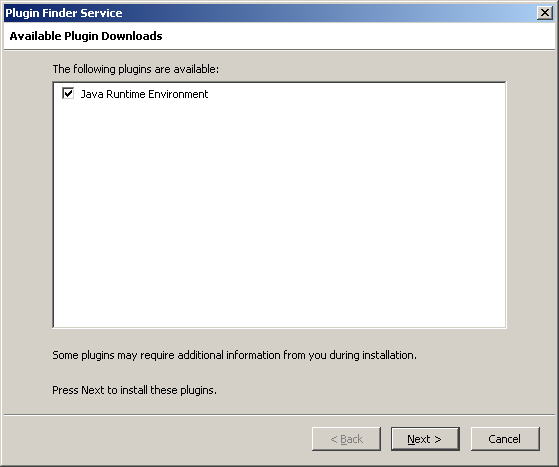Java Plugin Installation
Posted By admin On 05.09.19When you install the Java platform, the Java plug-in file is included as part of that installation.
To use Java within Firefox, manually create a symbolic link from the plug-in file in the release to one of the locations that Firefox expects. To make the plug-in available to all users, you must create the link inside of the Firefox application's directory, in the plug-ins subdirectory. Alternatively, you can create the symbolic link in your home directory, in ~/.mozilla/plug-ins. In the remainder of this document, the text, Firefox plug-ins directory implies either of these locations.
Note:
In the Add-ons Manager window, select Plugins; Click Java (TM) Platform plugin (Windows) or Java Applet Plug-in (Mac OS X) to select it; Check that the option selected is Ask to Activate or Always Activate or on older Firefox versions, click on the Enable button (if the button says Disable, Java is already enabled). When you install the Java platform, the Java plugin file is included as part of that install. If you want to use Java within Firefox, you need to manually create a symbolic link from the plugin file in the release to one of the locations that Firefox expects. To make the plugin available to all users, create the link inside of the Firefox.

For Firefox version 21 and later, you must create the symbolic link in your home directory, ~/.mozilla/plugins. However, creating the symbolic link in the plug-ins subdirectory of the Firefox application's directory is not supported in Firefox version 21 and later.
This release provides the Next-Generation Java plug-in. The plug-in file for Linux is located at jre–9.minor.security.patch/lib/amd64/libnpjp2.so.
Note
If you are using the classic plug-in file, which is located at ./plugin/i386/javaplugin-oji.so, then this file should no longer be used and all symbolic links to it must be removed.
See Oracle JDK 9 and JRE 9 Certified Systems Configurations.
Do you want to run Java programs, or do you want to develop Java programs? If you want to run Java programs, but not develop them, download the Java Runtime Environment, or JRE.
If you want to develop applications for Java, download the Java Development Kit, or JDK. The JDK includes the JRE, so you do not have to download both separately.
Which platform do you use? We support the following:
Java Plugin Install Firefox Ubuntu
Supported Systems ConfigurationIf you use an Apple product, such as a Macbook, please see the Apple Developer Connection to download the Java platform for your system.
Solaris Operating System
From the following table, select the instructions corresponding to your version of the Java release.
| JDK | JRE | ||
|---|---|---|---|
| Solaris | Solaris 64-bit | Solaris | Solaris 64-bit |
In order to run Java applets within a browser, you must install the JRE plugin manually. Instructions for that process are available here:

Microsoft Windows
Java Plugin Install Internet Explorer
From the following table, select the instructions corresponding to your version of the Java release.
| JDK | JRE | ||
|---|---|---|---|
| Windows | Windows 64-bit | Windows | Windows 64-bit |
Java Plugin Install Firefox
For most people, the installation instructions in the previous table are all that you need. The following advanced options, available only on Microsoft Windows, are also available.
- As of Java SE 6 Update 10, the release may be installed in one of two configurations: patch-in-place or static. For more information, see Java Runtime Environment Configuration.
- To quietly install the Java platform behind the scenes, and for information on other install options, see JRE Installer Options.
- When you need a quicker installation, the kernel installation is an option. In this scenario, a small set of core functionality is initially downloaded. For more information, see Java Kernel Installation.
- The Windows releases of Java Plug-in and Java Web Start support the ability to automatically download a particular version of the JRE. In this scenario, when the user launches a program using one of these mechanisms, the correct version of the JRE is installed behind the scenes, as needed. For more information, and for a list of available
.cabfiles, see Autodownload Files.
Linux
Some Linux platforms, such as Red Hat and SuSE, are RPM-based, which provide an automated way to install software. Some Linux distributions, such as Ubuntu, are not RPM-based. For these Linux systems, you must manually install the Java platform by using a self-extracting binary file.
From the following table, select the instructions corresponding to your version of the Java release.
| JDK | JRE | ||
|---|---|---|---|
| RPM Linux | RPM Linux 64-bit | RPM Linux | RPM Linux 64-bit |
| Self Extracting Linux | Self Extracting Linux 64-bit | Self Extracting Linux | Self Extracting Linux 64-bit |
In order to run Java applets within a browser, you must install the JRE plugin manually. Instructions for that process are available here:
- All platforms:Next-Generation Java PlugIn Technology introduced in JDK 6u10.